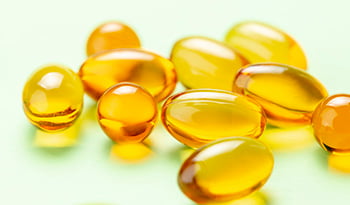5 Common Mineral Deficiencies
DISCLAIMER:This blog does not intend to provide diagnosis...

Minerals are chemical compounds or molecules found in nature. Though often mentioned alongside them, minerals are different than vitamins. They are inorganic substances that not only play an important role in the earth’s ecosystem but also in the overall health of all living organisms, including plants, animals, and humans.
Minerals are classified as major if greater than 5 grams of it are present in the human body. If there are less than 5 grams present, the mineral is considered a trace mineral. However, no matter their size, all minerals are crucial for enzymes, proteins, and cells to function at their optimum capacity.
Iron
Iron composes five percent of the earth’s crust, yet iron deficiency is the most common mineral deficiency worldwide. It is estimated that up to one in three people worldwide are low in this essential mineral. Women of childbearing age are at the highest risk. Men typically have a total of 4 grams of iron in their blood while women have 3 grams.
Iron is most famously known for its part in keeping red blood cells, or hemoglobin, at normal levels. When a person is low in iron, they are unable to produce adequate red blood cells, resulting in a condition known as anemia. While there are also other causes of anemia, such as vitamin B12 and folate deficiency, low iron is the leading reason a person will be anemic.
Iron comes in two forms: heme iron, which comes primarily from animal sources, and non-heme iron, which comes from plant sources. When iron is consumed in meat, the body will absorb about 30 percent of the heme-iron ingested. When iron is consumed from plants, nuts and seeds, about 10 percent of the non-heme iron will be absorbed.
Causes of Iron Deficiency
- Inadequate intake in diet
- Weight-loss surgery (gastric bypass, gastric sleeve, etc.)
- Heavy menstruation
- Stomach ulcers
- Colon polyps (which may bleed)
- Malabsorption syndrome
- Intestinal diseases (leaky gut, Crohn’s disease, ulcerative colitis, celiac disease)
Symptoms of Iron Deficiency
- Fatigue
- Pale appearance
- Shortness of breath
- Chest pain
- Heart palpitations
Food Sources of Iron
- Meat (beef, lamb, turkey, chicken, veal, etc.)
- Seafood (shrimp, clams, tuna, etc.)
- Vegetables (spinach, peas, broccoli, collards, kale, etc.)
- Fruits (strawberries, watermelons, raisins, dates, prunes, etc.)
- Beans (tofu, kidney beans, lentils)
Iron should only be taken if an iron deficiency has been diagnosed and food sources do not provide adequate iron. Some individuals have a condition called hemochromatosis, which results in iron overload. Once iron deficiency has been diagnosed and supplementation is advised, many also take vitamin C, which will help increase absorption.
Magnesium
An enzyme “co-factor” involved in over 350 chemical reactions in the human body, magnesium is crucial. The average human has about 25 grams of magnesium in the body. One percent of that is in the serum and red blood cells, and 90 percent of the serum is present in bones and muscles. A low level of magnesium in the blood indicates one is deficient. However, a normal blood test can also result when one lacks sufficient magnesium in the body. Overall, it is estimated that up to 75 percent of the world’s population consumes inadequate amounts of magnesium required for peak health.
An adequate intake of magnesium-rich foods, which includes green leafy vegetables, is important. Frequently, diet is not enough and a supplement is required.
Certain medications increase the risk of magnesium deficiency. These medications include acid reducers (i.e. omeprazole, pantoprazole, ranitidine) and diuretic water pills (i.e. furosemide, triamterene, hydrochlorothiazide).
Causes of Magnesium Deficiency
- Inadequate intake through diet
- Weight-loss surgery (gastric bypass, gastric sleeve, etc.)
- Malabsorption
- Intestinal diseases (Crohn’s disease, ulcerative colitis, celiac disease)
Symptoms of Magnesium Deficiency
- Muscle cramps
- Leg cramps (especially at night)
- Eyelid twitches
- Heart palpitations
- Elevated blood pressure
- Migraine headaches
- Tension headaches
- Anxiety symptoms
- Constipation
- Poor glucose control
- Overactive bladder (bladder is a smooth muscle)
Food Sources of Magnesium
- Pumpkin seeds
- Almonds
- Spinach
- Cashews
- Edamame
- Black beans
- Dark chocolate
- Peanut butter
- Avocado
- Soy milk
Obtaining magnesium through diet is best. However, that is frequently not enough, even in those with healthy, well-rounded diets. Magnesium is available as a powder, tablet, or capsule. A magnesium chelate (such as magnesium citrate, magnesium glycinate, magnesium malate, or magnesium threonate) formula is ideal for optimal absorption and efficiency. A magnesium-oxide formulation is acceptable but occasionally has gastrointestinal side effects, such as loose stool, for some. Take as directed on the label. Those with advanced kidney disease should consult with their physician prior to taking.
Calcium
Calcium is one of the most common minerals in the body and on earth. In fact, up to two percent of our body weight is composed of calcium. It is estimated that 99 percent of the calcium in our bodies is found in our bones, while one percent is circulating in blood and present in cells.
Calcium is responsible for bone and muscle health, including heart muscle contractions. When sufficient calcium is not consumed in the diet, health complications may occur. When consumed with food, calcium and magnesium are usually balanced. When a supplement is taken, one should also add a magnesium supplement. In addition, adequate levels of vitamin D are required for the absorption of calcium.
Causes of Calcium Deficiency
- Vitamin D deficiency
- Poor dietary intake
- Weight-loss surgery (gastric bypass, gastric sleeve, etc.)
- Malabsorption
- Intestinal diseases (leaky gut, Crohn’s disease, ulcerative colitis, celiac disease)
Symptoms of Calcium Deficiency
- Dental issues
- Depression
- Brittle nails
- Fatigue
- Hallucinations
- Menstrual cramps
- Muscle cramps
- Osteopenia/Osteoporosis
Food Sources of Calcium
- Seeds (chia seeds, sesame seeds)
- Dairy (cheese, yogurt)
- Beans and lentils
- Almonds
- Whey protein
- Soy milk
- Green leafy vegetables
- Figs
When diet does not provide adequate calcium, one may need to add a calcium supplement to their daily regimen. Most who supplement take 500 mg to 1,000 mg daily. Calcium carbonate requires adequate stomach acid for absorption, so taking it with a meal is best. Those who take acid reducers are best taking a calcium citrate formulation. Other forms such as coral calcium, calcium gluconate, or calcium lactate are also acceptable. Some also take calcium-magnesium combinations or calcium-magnesium-zinc combination supplements.
Iodine
It is estimated that, globally, one in three people have insufficient iodine intake. Adequate iodine is required for the production of the thyroid hormone and energy metabolism. Those with symptoms listed below or those with a thyroid condition should consult with their physician about having a urine iodine level checked. Normal urine levels are > 100 mcg/L or more.
When deficient, one may develop a goiter (thyroid enlargement) or thyroid nodules. Low iodine levels are also associated with fatigue, low body temperature, and reduced intelligence (up to 13.5 points) as measured on a standardized IQ test. Severe deficiency within a fetus and early childhood may result in mental retardation.
Iodine deficiency is common in Africa and South Asia, while 50 percent of people in Europe are also mildly deficient, according to a study in Endocrine Reviews.
A 2018 study of Norwegian pregnant women in Nutrients showed that up to 55 percent of the women had suboptimal iodine intake in their diet. According to the Australian Thyroid Foundation, “More than 50% of children and pregnant or breastfeeding women living in Australia have been shown to be iodine-deficient”.
Further, a 2011 study in the Journal Thyroid demonstrated that almost 10 percent of people in the United States had moderate to severe iodine deficiency. It is believed that an additional five to 10 percent are mildly deficient. In other words, one in five Americans may also be deficient.
Those in Japan tend to have a higher intake of iodine than most other countries due to routine consumption of wakame (undaria), nori (porphyra), and kombu (laminaria), types of seaweed.
Causes of Iodine Deficiency
- Poor dietary intake
- Weight-loss surgery (gastric bypass, gastric sleeve, etc.)
- Malabsorption
- Intestinal diseases (leaky gut, Crohn’s disease, ulcerative colitis, celiac disease)
Symptoms of Iodine Deficiency
- Cold fingers and toes
- Fatigue
- Thyroid nodules/Goiter
- Under-active thyroid
- Depression
- Brain fog/trouble learning and remembering things
- Weight gain
- Hair loss
- Dry skin
Food Sources of Iodine
- Seafood (tuna, shrimp, and cod)
- Seaweed (wakame, nori, kombu)
- Vegetables
- Dairy (yogurt, cottage cheese, cow’s milk)
- Eggs
- Prunes
- Iodized salt
When diet is not sufficient, a quality multivitamin should be taken, as long as it has 150 mcg of iodine present. Some also take kelp supplements to help ensure they are getting adequate iodine. The European Union has recommended 600 mcg be the upper limit of iodine taken when supplementing.
Zinc
According to the World Health Organization, it is estimated that up to 20 percent of the world’s population could be deficient in zinc. When young children are affected, growth can be stunted while the immune system can also be negatively affected, making it more difficult to fight off dangerous bacteria and viruses. Children in South Asia, Africa, and the Western Pacific are at higher risk than children in other locations around the world. In North America and Europe, the elderly are at higher risk for deficiency than children.
Causes of Zinc Deficiency
- Poor dietary intake
- Weight-loss surgery (gastric bypass, gastric sleeve, etc.)
- Malabsorption
- Routine alcohol ingestion
- Intestinal disorders (Crohn’s disease, ulcerative colitis, celiac disease)
- Medications (diuretic medications used for blood pressure)
Food Sources of Zinc
- Oysters
- Meat (beef, veal)
- Poultry (chicken, turkey)
- Seafood (fish, crab and lobster)
- Seeds (hemp, pumpkin, sunflower, pecan, chia seeds, flax seeds)
- Nuts (pine nuts, cashews, brazil nuts)
The Symptoms of Zinc Deficiency
- Dry skin (dermatitis)
- Loss of smell
- Poor wound healing
- Retarded growth (if children are deficient)
- Diarrhea
- Mental disturbances
- Memory loss
- Hair loss
- Impotence
- Recurrent infections due to reduced immunity
Depending on one’s age, between 2 mg and up to 13 mg of zinc per day are recommended — breastfeeding women having highest requirements, and infants have the lowest. Most quality multivitamins contain zinc. There are also calcium-magnesium-zinc combination supplements which are beneficial for bone health. Some, however, may need additional zinc and take a zinc supplement. Zinc lozenges are taken frequently during the cold and flu season to help prevent upper respiratory infections.
References:
- Food sources of iron according to the Red Cross https://www.redcrossblood.org/donate-blood/blood-donation-process/before-during-after/iron-blood-donation/iron-rich-foods.html
- Wacker WE, Parisi AF N Engl J Med. 1968 Mar 21; 278(12):658-63. (Average human has 25 grams of magnesium in their body)
- DiNicolantonio JJ, O'Keefe JH, Wilson W. Subclinical magnesium deficiency: a principal driver of cardiovascular disease and a public health crisis [published correction appears in Open Heart. 2018 Apr 5;5(1):e000668corr1]. Open Heart. 2018;5(1):e000668. Published 2018 Jan 13. doi:10.1136/openhrt-2017-000668
- Lima Mde L, Pousada J, Barbosa C, Cruz T Arq Bras Endocrinol Metabol. 2005 Dec; 49(6):959-63 [Magnesium deficiency and insulin resistance in patients with type 2 diabetes mellitus]. Up to 75% of people are deficient
- Mineral and Electrolyte Metabolism. 1993;19(4-5):314-22. Low magnesium is associated with glucose abnormalities
- Endocrine Reviews. 2009 Jun;30(4):376-408. doi: 10.1210/er.2009-0011. Epub 2009 May 21.
- Nutrients. 2018 Feb 28;10(3). pii: E280. doi: 10.3390/nu10030280.
- Site accessed March 3, 2018 regarding iodine deficiency in Australia. https://www.thyroidfoundation.org.au/page/13/iodine-nutrition-iodine-deficiency
- Thyroid. 2011 Apr; 21(4):419-27. doi: 10.1089/thy.2010.0077. (Note: Iodine deficiency in the United States is higher than 10% of the population. I suspect upwards towards 20% using the WHO urinary value of 100 mg/L or less being deficient)
- Food sources of zinc https://ods.od.nih.gov/factsheets/Zinc-Consumer/

 By Dr. Eric Madrid, M.D.
By Dr. Eric Madrid, M.D.


